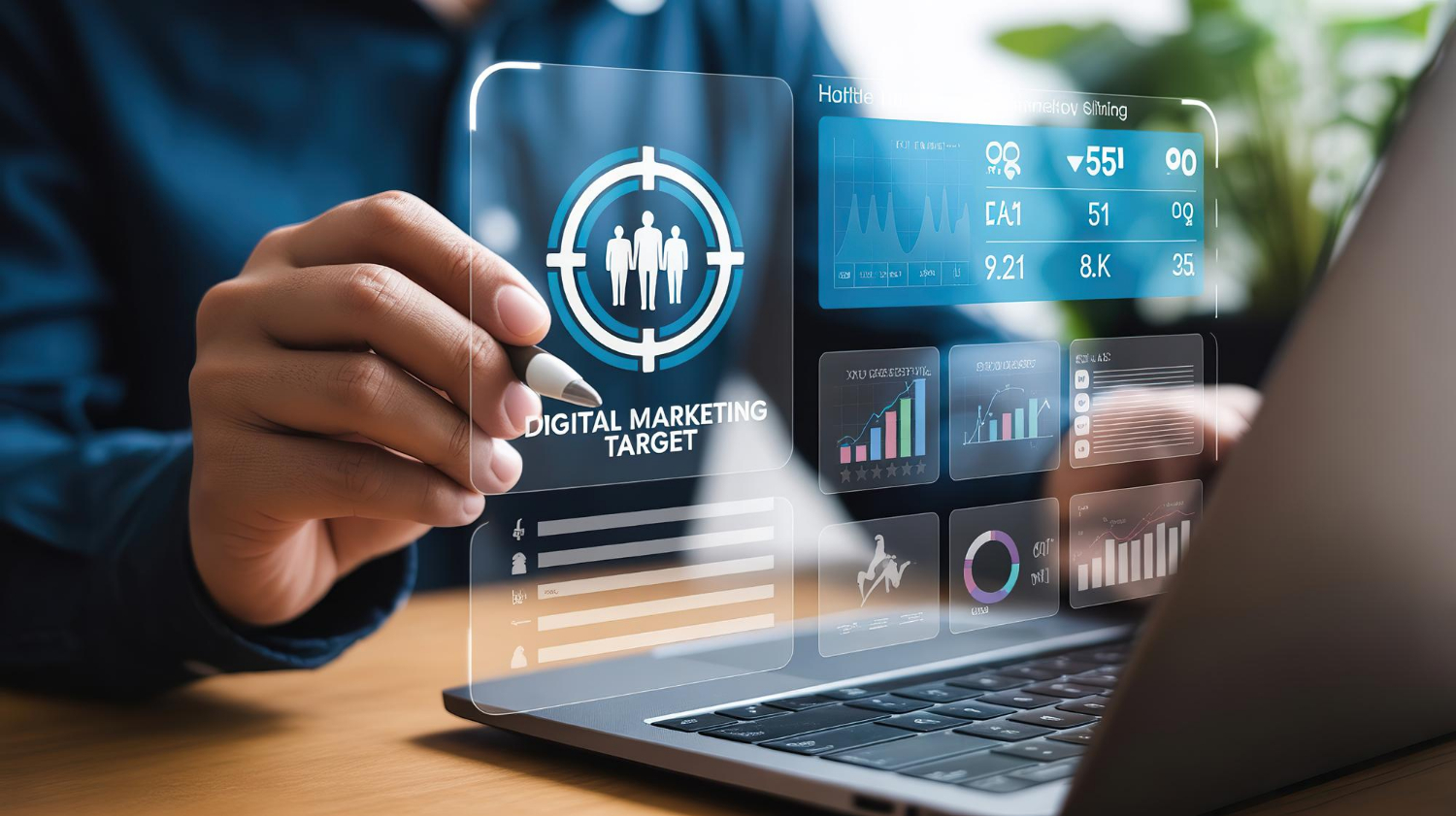A startling fact shows that 87% of marketers acknowledge data as their company’s most underused resource.
Companies that apply data-driven strategies to marketing generate five to eight times more ROI than their competitors. Marketing executives understand this – 64% believe evidence-based marketing is vital in today’s digital world. Yet only 53% of marketing decisions rely on data-driven marketing
This piece will help you build evidence-based marketing insights that directly affect your profits. You’ll learn to convert marketing data into practical strategies, especially now that 71% of customers expect tailored interactions from brands.
Want to revamp your marketing strategy and increase sales? Let’s explore the steps you need right now.
Understand Your Customers Through Data
“Every trackable interaction creates a data-point, and every data-point tells a piece of the customer’s story.” —Paul Roetzer, Founder and CEO, Marketing AI Institute
Your marketing success depends on how well you know your audience. Companies that utilize customer behavior data see 85% better sales growth and 25% higher gross margins than their competitors. You need two effective data collection methods to understand what your customers want.
Collect first-party and behavioral data
First-party data has become vital as privacy rules get stricter. This data comes directly from your customers and audience. Acquia’s 2022 report shows that 88% of marketers think that first-party data matters more to organizations now than ever. Since it comes straight from the source, this data proves both accurate and reliable for your analytical marketing strategy.
Your first-party data sources include:
- Website interactions: Track user behavior, page views, clicks, and time spent on different sections
- Customer accounts and transactions: Purchase history, order details, and account information
- Preference centers: Let customers choose their communication priorities
- Surveys and feedback forms: Direct insights about customer opinions and satisfaction
- CRM systems: Track all customer interactions at various touchpoints
Behavioral data proves especially valuable because it changes constantly, unlike demographics. This dynamic information shows immediate customer intent rather than depending on educated guesses from demographic grouping. You can spot in-market consumers early in their experience and deliver the right content at the perfect moment.
Google Analytics, CRM platforms, and specialized data management solutions help you get the most from your analytical marketing insights. Cookies and pixels also help track user activity across channels while following privacy rules.
Use conversation analytics for deeper insights
Traditional analytics show what customers do, but conversation analytics explains why. AI and natural language processing analyze customer interactions through calls, chats, emails, and social media. These tools turn unstructured communication data into useful marketing insights.
Conversation analytics lets businesses study both sides of an interaction. You can track customer thoughts, feelings, and representative responses. This gives you valuable understanding of your customers’ true feelings and what drives them.
This approach captures feedback naturally. Unlike surveys that interrupt the customer’s experience, conversational data comes from interactions that customers start on their own. You get a more genuine picture of their needs, problems, and emotional responses.
Modern conversation analytics platforms can identify:
- Customer sentiment and emotional intensity
- Common questions and issues
- Purchase intent signals
- Points of friction in the customer’s experience
- Emerging trends and opportunities
A complete picture of your customer emerges when you combine behavioral data with conversation analytics. Organizations using this detailed approach to data collection discover unprecedented opportunities for personalization. Research shows that in-market monitoring and behavioral insights affect ROI, increase involvement, and improve retention rates.
Marketing teams can target more precisely, create better content, and improve every customer touchpoint with these insights. This drives the sales growth that sets leading companies apart from their competitors.
Segment and Map the Customer Journey
Your next step is to organize customer data through smart segmentation and journey mapping after building a solid data foundation. These methods turn raw data into marketing actions that boost sales by showing exactly who your customers are and how they connect with your brand.
Group users by behavior and intent
Behavioral segmentation split your audience based on how they act and interact with your business. Unlike demographic grouping, behavioral data shows what customers want right now, which lets you group them by shared engagement patterns.
The best ways to segment behavior include:
- Purchase behavior: Looking at when and how customers buy helps predict demand and tells you when your marketing will work best
- Journey stage: Grouping people by their phase – awareness, consideration, decision, retention, and advocacy – helps create messages that convert better
- Channel priorities: Knowing which platforms your customers use most helps you spend your marketing budget on what works
- Loyalty levels: Looking at how often customers engage shows what builds brand loyalty and helps boost customer lifetime value
Intent segmentation, a special type of behavioral grouping, shows when prospects are ready to buy based on what they do. These signals come from website activity like pricing page visits, scroll depth, time spent reading, and searches using buying-focused keywords.
Behavioral segmentation brings many benefits: better conversion rates, stronger retention, more accurate predictions, and smarter marketing spending. As you roll out your evidence-based marketing strategy, these insights let you deliver custom content that fits each group’s specific needs.
Create journey maps to identify key touchpoints
A customer journey map shows every interaction between customers and your company throughout your relationship. It might look simple at first, but these maps reveal how customers take different paths across multiple channels when they deal with your brand. starts with creating a single view of the customer.
Here’s how to build an effective customer journey map:
1.Define your scope – Pick one persona with one clear goal
2.List all touchpoints – Find every way customers interact with your brand, both direct and indirect
3.Map the current journey – Write down how customers currently move through their experience
4.Plot customer sentiment – See how customers feel at each step to find problem areas
5.Identify opportunities – Study the map to see what you can improve
Journey maps uncover those special moments that really matter to customers. They also highlight important after-purchase stages that many companies miss, which helps your marketing cover the complete customer lifecycle.
Journey mapping helps you see beyond single purchases to understand the whole customer experience. It shows the why behind customer actions, not just the what, and gives insights you won’t find in regular analytics.
These maps are a great way to get value for data-driven marketing by finding pain points, keeping messages consistent across channels, and spotting chances to personalize. All this helps you make every touchpoint better, remove obstacles, and create an experience that flows smoothly to drive sales.
Personalize Marketing with Data-Driven Insights
Your customer data organization sets the stage for creating customized experiences. Today’s consumers just need companies to deliver personalized interactions . Data-driven personalization has become essential to drive sales.
Deliver dynamic content based on user behavior
Dynamic content changes automatically based on your customers’ interactions, priorities, and demographics. Static content stays the same for everyone, while dynamic content creates unique experiences for each visitor.
This customized approach works well across these touchpoints:
- Website personalization: Your landing pages adapt based on previous interactions. Product recommendations become relevant, and messaging adjusts to visitor location and behavior. Users become 84% more likely to connect with your content when you customize it this way.
- Email customization: Advanced dynamic email content goes beyond using customer names. It adapts to recipient profiles and past interactions. Customized emails boost ROI and improve engagement by showing customers you get their needs.
- Search and social ads: Dynamic elements make search campaigns relevant to specific audience segments. Facebook and Instagram provide built-in tools to create dynamic experiences throughout your customer’s trip.
Your dynamic content should flow through the customer’s entire trip. The awareness stage focuses on meeting user intent and guiding next steps. Trust builds through custom experiences during the consideration phase. The decision phase uses customer data to guide prospects toward conversion.
Use predictive analytics to anticipate needs
Predictive analytics takes customization further by forecasting customer needs before they surface. Machine learning and AI analyze historical data to predict customer behavior and priorities with remarkable accuracy.
Predictive analytics has changed marketing strategies through these key applications:
- Customer segmentation: Smart algorithms find patterns in user behavior to create precise customer segments beyond traditional methods.
- Personalized recommendations: Your customers’ browsing patterns and purchase history reveal which products will interest them most.
- Churn prevention: Early warning signs help you spot customers likely to leave, so you can start targeted retention campaigns.
- Demand forecasting: Past sales data and market indicators help predict the best timing for product campaigns.
The numbers tell the story. Companies using predictive analytics for customization see more customer engagement, higher conversion rates, and improved customer loyalty. This happens because they address individual needs instead of generic ones.
Your success depends on gathering various data types – behavioral patterns, purchase history, and contextual information. Machine learning models then help predict behaviors like churn risk, product interest, or potential service issues.
Optimize Every Channel for Conversions
Strategic application of data across customer touchpoints creates measurable sales results. Your next step after becoming skilled at personalization should focus on making each brand interaction channel better.
Tailor website experiences using past interactions
Smart website personalization changes basic pages into experiences that adapt to each visitor’s needs. Tracking user behavior helps display content that seems custom-built for everyone who visits. To cite an instance, showing product recommendations based on browsing history creates better engagement that gets more and thus encourages more conversions.
Studies show customized web experiences can increase sales and strengthen customer loyalty. Customers who find content matching their interests will likely return and buy more. Good website personalization reads customer needs and responds with customized experiences that make them feel special.
Website personalization might seem complex, but it brings great results – better leads, stronger marketing ROI, and a clear edge over competitors.
Improve call routing and phone experiences
Phone calls remain vital points of contact in a customer’s trip. Smart call routing connects callers with the right department or agent without extra transfers.
Better call routing makes higher by cutting wait times and solving problems on the first call. Matching customers with agents who know their stuff makes work faster and cuts down solution times.customer satisfaction
Your call routing system should work smoothly with your CRM platform. Agents can then see customer details right away and give customized service from hello.
Use to refine email and ad targeting CRM data
CRM data gives you that complete customer picture needed for focused marketing. CRM insights let you build campaigns for specific groups instead of sending general messages.
Studies show 71% of customers like targeted marketing better than mass approaches. Companies that use data well are 23X better at getting customers and 6X better at keeping them compared to others.
CRM data works best when you:
- Group audiences by their actions and priorities
- Customize marketing messages (making conversion better by up to 42%)
- Focus ads on specific customer actions like pricing page visits
- Build lookalike audiences similar to your best customers
These focused methods make every marketing dollar work harder while giving customers the customized experience they want today.
Track Results and Scale What Works
“Without actionable data and clear metrics driven strategy, the marketing organization is being paid to guess.” —Team Position 2, Digital Marketing Agency
Strategy implementation alone won’t cut it. You must keep a close eye on performance to find what works and build on those wins. Measuring results the right way brings better ROI, smarter budget decisions, and improved strategic planning.
Monitor performance across all channels
Up-to-the-minute data analysis is the foundation of data-driven marketing. I can make quick adjustments that improve outcomes by a lot when I watch campaigns as they run. This constant analysis helps me spot areas that need work before the next campaign launches.
My performance tracking across channels includes:
- KPI dashboards: These central tools collect data from phone calls, websites, ad networks, and CRM software. They combine this information to show which campaign elements succeed. This united view gives detailed insights into the customer’s trip across touchpoints.
- Cross-channel analytics: The systematic collection and analysis of marketing data from multiple channels gives me a complete picture of customer interactions. This all-encompassing approach shows how different channels work together to boost conversions.
- I measure progress and set realistic goals during the monitoring process. My analysis looks at metrics as a group instead of one by one. This method gives better insights than simple assessments on their own.
Use attribution to identify top-performing strategies
shows which touchpoints lead to conversions. It helps me find the channels and strategies that drive the best results. This method pinpoints exactly which parts of my marketing strategy affect conversion rates the most.Marketing attribution
Studies show attribution boosts efficiency by 15-30% through better resource allocation. This lets me optimize marketing spend by putting money into high-performing channels while cutting back on underperforming ones.
The right attribution model must match my business needs. Many attribution models exist, but picking the right one is vital. The wrong choice can lead to poor marketing decisions.
Regular attribution data analysis helps me adapt quickly to market changes and shifting consumer behavior. This analytical approach helps prove marketing expenses and gets stakeholders excited about future projects.
Conclusion
Data-driven marketing helps businesses grow with measurable results. Companies using this method perform better than their competitors and build stronger customer relationships. Success comes from mixing strong data collection with strategic segmentation and customized channel experiences.
The numbers back this up. Organizations with data-driven strategies achieve 5-8x better ROI than those who guess. Companies that track behavior and analyze conversations learn about their customers better. This leads to precise targeting and better sales.
Moving forward requires steady measurement, analysis, and optimization. Smart marketers use data to avoid mistakes that get pricey while finding new ways to grow. to find more revenue opportunities with useful insights.See LayerFive in action
Note that successful data-driven marketing needs the right tools and mindset. Start small, test carefully, and expand what works. Your marketing becomes more focused, your customers happier, and your sales will show the benefits of using real data instead of assumptions.
FAQs
Q1. What are the key steps to building a data-driven marketing strategy?
A data-driven marketing strategy involves collecting customer data, identifying effective marketing channels, creating personalized content, and continuously refining your approach based on insights. It’s crucial to respect customer privacy and comply with data protection regulations throughout the process.
Q2. How does data-driven marketing improve campaign performance?
Data-driven marketing enhances campaign performance by enabling marketers to identify the most effective touchpoints and messages that drive conversions. Through continuous analysis and optimization, businesses can improve conversion rates and maximize their return on investment.
Q3. What are data-driven insights in marketing?
Data-driven insights are conclusions drawn from analyzing raw data to identify patterns and trends. These insights help businesses understand their customers better, create targeted campaigns, uncover new opportunities, and enhance the overall customer experience.
Q4. How can businesses use intent data in their sales strategies?
Intent data is a powerful tool for data-driven sales strategies. It provides real-time insights that help marketing and sales teams make informed decisions and build strategies. Utilizing intent data can lead to generating nearly twice as many leads compared to traditional methods.
Q5. What are some effective ways to personalize marketing using data?
Effective personalization strategies include delivering dynamic content based on user behavior, using predictive analytics to anticipate customer needs, tailoring website experiences based on past interactions, and refining email and ad targeting using CRM data. These approaches can significantly boost engagement and conversions.



